
Rutgers University, officially known as Rutgers, The State University of New Jersey, is a public land-grant research university based in New Brunswick, New Jersey. Chartered in 1766, Rutgers was originally called Queen's College. It is the eighth-oldest college in the United States, the second-oldest in New Jersey, and one of the nine U.S. colonial colleges that were chartered before the American Revolution. In 1825, Queen's College was renamed Rutgers College in honor of Colonel Henry Rutgers, whose substantial gift to the school had stabilized its finances during a period of uncertainty. For most of its existence, Rutgers was a private liberal arts college but it has evolved into a coeducational public research university after being designated The State University of New Jersey by the New Jersey Legislature via laws enacted in 1945 and 1956.

Rutgers–Newark is one of three regional campuses of Rutgers University, New Jersey's State University. It is located in Newark. Rutgers, founded in 1766 in New Brunswick, is the eighth oldest college in the United States and a member of the Association of American Universities. In 1945, the state legislature voted to make Rutgers University, then a private liberal arts college, into the state university and the following year merged the school with the former University of Newark (1936–1946), which became the Rutgers–Newark campus. Rutgers also incorporated the College of South Jersey and South Jersey Law School, in Camden, as a constituent campus of the university and renamed it Rutgers–Camden in 1950.

The School of Environmental and Biological Sciences (SEBS) is a constituent school within Rutgers, The State University of New Jersey's flagship New Brunswick-Piscataway campus. Formerly known as Cook College—which was named for George Hammell Cook, a professor at Rutgers in the 19th Century—it was founded as the Rutgers Scientific School and later College of Agriculture after Rutgers was named New Jersey's land-grant college under the Morrill Act of 1862. Today, unlike the other arts and sciences schools at Rutgers, the School of Environmental and Biological Sciences specializes in environmental science, animal science and other life sciences. Although physically attached to the New Brunswick-Piscataway campus, most of the SEBS campus lies in North Brunswick, New Jersey.
Douglass Residential College, part of Rutgers University-New Brunswick, is an undergraduate, non degree granting higher education program of Rutgers University-New Brunswick that is specifically for women. It succeeded the liberal arts degree-granting Douglass College after it was merged with the other undergraduate liberal arts colleges at Rutgers-New Brunswick to form the School of Arts and Sciences in 2007. Originally named the New Jersey College for Women when founded in 1918 as a degree granting college, it was renamed Douglass College in 1955 in honor of its first dean. Female students enrolled at any of the academic undergraduate schools at Rutgers–New Brunswick, including, e.g., the School of Arts and Sciences, School of Engineering, School of Environmental and Biological Sciences, School of Pharmacy, Mason Gross School of the Arts, may now also enroll in Douglass Residential College, which offers special enrichment and career preparation experiences, special projects, and educational and service travel, and at which they must satisfy additional requirements specific to the college. Douglass seeks to provide the benefits of a close-knit small community of women students and offers programs specially designed to help women students to identify their unique abilities and develop confidence. These programs include, for example, a strong emphasis on opportunities to participate in service/learning trips in foreign countries, support for and expansion of racial and cultural diversity, and a wide range of training and enrichment activities offered by a career and leadership development center known as the "BOLD" Center.
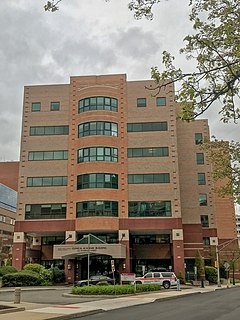
Rutgers Robert Wood Johnson Medical School is a medical school of Rutgers University. It is one of the two graduate medical schools of Rutgers Biomedical and Health Sciences, together with New Jersey Medical School, and is closely aligned with Robert Wood Johnson University Hospital, the medical school's principal affiliate.

College Avenue Gymnasium is an athletic facility on the College Avenue Campus of Rutgers University in New Brunswick, New Jersey.

Voorhees Mall is a large grassy area with stately shade trees on a block of about 28 acres (0.11 km²) located on the College Avenue Campus of Rutgers University near downtown New Brunswick, New Jersey. An eclectic mix of architectural styles, Voorhees Mall is lined by many historic academic buildings. The block is bound by Hamilton Street, George Street (north), College Avenue (south) and Seminary Place (west). At the mall's western end, across Seminary Place, is the campus of the New Brunswick Theological Seminary, whose history is intertwined with the early history of Rutgers University. Across Hamilton Street is the block called Old Queens, the seat of the university.
As one of the first nine colleges founded in the United States of America—founded as Queen's College in 1766 —Rutgers, The State University of New Jersey has two-and-a-half centuries of tradition and heritage.
The School of Arts and Sciences is an undergraduate constituent school at the New Brunswick-Piscataway area campus of Rutgers University. Established in 2007 from the merger of Rutgers' undergraduate liberal arts colleges and the non-student college known as the "Faculty of Arts and Sciences," the School of Arts and Sciences was implemented to centralize and consolidate undergraduate education at the university, focusing on providing one set of admissions and graduation requirements and imposing a universal core curriculum.

Rutgers University–New Brunswick is one of three regional campuses of Rutgers University, New Jersey's public research university. It is located in New Brunswick and Piscataway. It is the oldest campus of the university, the others being in Camden and Newark. The campus is composed of several smaller campuses: College Avenue, Busch, Livingston,Cook, and Douglass, the latter two sometimes referred to as "Cook/Douglass", as they are adjacent to each other. Rutgers–New Brunswick also includes several buildings in downtown New Brunswick. It is classified among "R1: Doctoral Universities – Very high research activity".
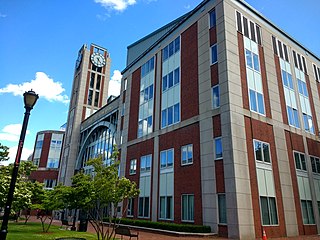
Rutgers Law School is the law school of Rutgers University, with classrooms in Newark and Camden, New Jersey. It is the largest public law school and the 10th largest law school, overall, in the United States. Each class in the three-year J.D. program enrolls approximately 350 law students. Although Rutgers University dates from 1766, its law school was founded in Newark in 1908. Today, Rutgers offers the J.D. and a foreign-lawyer J.D., as well as joint-degree programs that combine a J.D. with a graduate degree from another Rutgers graduate program. Rutgers has law alumni who practice in every U.S. state and in foreign jurisdictions throughout the world. Current well-known alumni include U.S. Senators Elizabeth Warren (MA) and Robert Menendez (NJ) and three of seven sitting justices on the New Jersey Supreme Court. The late United States Supreme Court Justice Ruth Bader Ginsburg was a member of the Rutgers law faculty early in her career. Rutgers serves a unique role in New Jersey's legal landscape: the current Constitution of New Jersey was adopted in 1947 pursuant to a convention at Rutgers University, and the Rutgers Law Library serves as a repository of New Jersey's key legal documents from the colonial era through current legislation and case law.

The Sophia Astley Kirkpatrick Memorial Chapel, known as Kirkpatrick Chapel, is the chapel to Rutgers, The State University of New Jersey and located on the university's main campus in New Brunswick, New Jersey in the United States. Kirkpatrick Chapel is among the university's oldest extant buildings, and one of six buildings located on a historic section of the university's College Avenue Campus in New Brunswick known as the Queens Campus. Built in 1872 when Rutgers was a small, private liberal arts college, the chapel was designed by architect Henry Janeway Hardenbergh at the beginning of his career. Hardenbergh, a native of New Brunswick, was the great-great-grandson of Rutgers' first president, the Rev. Jacob Rutsen Hardenbergh. It was the third of three projects that Hardenbergh designed for the college.

Geology Hall, formerly Geological Hall, also known as the Rutgers Geology Museum, is a building located in the historic Queens Campus section of Rutgers, The State University of New Jersey's College Avenue Campus in New Brunswick, New Jersey, United States.
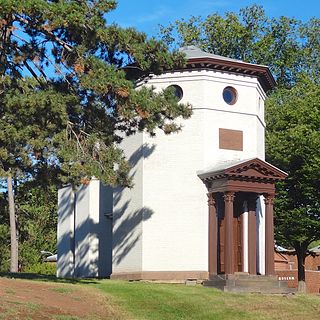
The Daniel S. Schanck Observatory is an historical astronomical observatory on the Queens Campus of Rutgers University in New Brunswick, New Jersey, United States, and is tied for the seventh oldest observatory in the US alongside the Vassar College Observatory. It is located on George Street near the corner with Hamilton Street, opposite the parking lot adjacent to Kirkpatrick Chapel, and to the northeast of Old Queens and Geology Hall.

The Queens Campus or Old Queens Campus is a historic section of the College Avenue Campus of Rutgers, The State University of New Jersey in New Brunswick, New Jersey, in the United States.
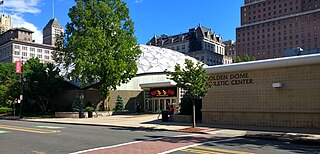
The Golden Dome Athletic Center in Newark, New Jersey is the hub of Rutgers–Newark athletics and teams, the Scarlet Raiders. It is located at 42 Warren Street between Downtown and University Heights. Built in 1977, it seats 2,000. The facility includes two gyms, five outdoor tennis courts, four racquetball courts, an exercise/dance studio and a 25-yard, eight-lane pool.
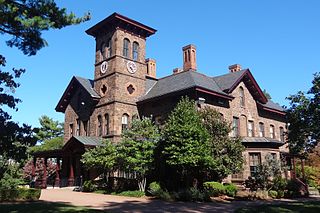
The Levi D. Jarrard House is a historic building located on the Douglass College campus of Rutgers University in New Brunswick, New Jersey. It was constructed in 1868 by an unknown architect, as a private residence for Levi D. Jarrard. Levi D Jarrard, was acting as Postmaster of New Brunswick from 1881-1883, but was previously employed as a New Jersey State Senator as well as the Middlesex County Collector. In 1883 he was found to have embezzled approximately $20,000, and had fled to Canada with the funds, leaving his family to struggle with payments on the house. The house was then purchased by John N. Carpender, who would later lease it to the New Jersey College for Women.
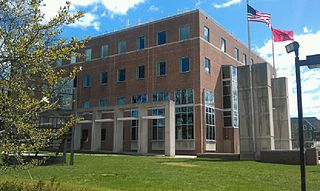
Archibald S. Alexander Library is the oldest and main university library for Rutgers University–New Brunswick. It houses an extensive humanities and social science collection and also supports the work of faculty and staff at four professional schools: the Edward J. Bloustein School of Planning and Public Policy, the Graduate School of Education, the Graduate School of Social Work, and the School of Communication and Information. In addition, Alexander supports major interdisciplinary programs in African studies, Latin American studies, medieval studies, and South Asian Studies.
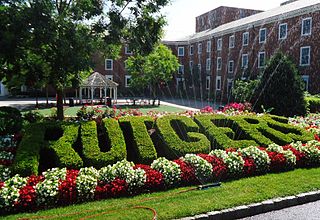
College Avenue is the oldest campus of Rutgers University – New Brunswick, in New Brunswick, New Jersey, U.S. It includes the historic seat of the university, known as Old Queens. Many classes are taught in the Voorhees Mall area, also home to the Zimmerli Art Museum. The grounds of the New Brunswick Theological Seminary are within the campus area, which is within walking distance of shops, restaurants, and theaters in downtown New Brunswick. It is served by Rutgers Campus Buses, a zero-fare bus network.















